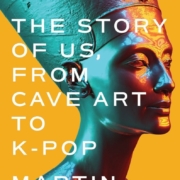The Radium Girls: The Dark Story of America’s Shining Women by Kate Moore
When perusing the library’s new book offerings, Kate Moore’s The Radium Girls shone from the shelf. Particularly, the subtitle: The Dark Story of America’s Shining Women. Intrigued and unfamiliar with these shining women and their dark story, I trusted Moore to shed light on the matter. She begins by introducing us to a list of key characters, including the dial-painters (i.e. the “radium girls”), corporations, doctors, and investigators involved, and she ends with an impressive bibliography, illuminating her skillful, thorough research of the women’s decades-long struggle for justice.
Discovered in 1898 by Pierre and Marie Curie, radium is a chemical element that, not long after its discovery, was used in readily available medicines and for other common, commercial purposes. One such purpose was luminous watch-dials and instruments, which were in high demand during both World Wars. Despite radium’s increasingly apparent toxicity, which was not known to the public, corporations continued to hire young women as dial-painters in their factories or, as they were referred to, their “studios.”
Working as a dial-painter was an enviable position. The work was considered higher up than that of other factory jobs and, for that day and age, it paid very well. Plus, the women employed were captivated by the radium, which they regarded as a glamorous “wonder element.” From as young as 14 years old, girls and women painted watch-dials with a paint containing radium powder, which they mixed themselves without precaution. To be clear, they were told by their employers that radium was perfectly safe, that it was not necessary to use precaution.
Dust from the radium powder settled on everything, including their clothes, their hair, their skin. Also, their lips, as they were taught the technique of lip-pointing when instructed how to paint watch dials. This technique became known as the “lip, dip, and paint” routine. They made a point of the brush by touching it to their lips, dipped it in the radium, and painted the dials. Over and again, all day long. It didn’t take too long for the women to start glowing at night. Literally. Onlookers were impressed, including the women themselves, and thought their radium-girl glow glamorous. And it was. That is, until it wasn’t.
Many dial-painters started experiencing health issues, such as headaches, sore or falling-out teeth, crumbling jaws, growths and tumors, and other serious symptoms. Mystified, the doctors from whom they sought treatment often did not know what to do, as they had never seen such symptoms. Too often, either the wrong treatment was administered or nothing at all. As the women and their doctors pieced the puzzle together, eventually realizing their ailments were related to working with radium, they confronted the companies for which the women worked. In the spirit of corporate greed, the companies denied exposure to radium as the cause and maintained that it was safe to work with.
Although the companies were denying the ill-effects of radium, they made half-hearted (at best) efforts to improve work environments, no longer allowing the women to lunch on the same table where they painted watch dials and providing water for the women to dip their brushes into. They also periodically brought in doctors to run tests and monitor the women’s health. However, the results were not shared, not even with the women. Sadly, some women were ensured of their health by employers only to find out later they had been in declining health all along. In addition to their claims being dismissed by their employers, the ill-fated radium girls were sometimes criticized in their communities, as others saw their actions as a jeopardy to much-needed jobs within the community.
Eventually, the radium girls’ claims were taken seriously. Rather seriously enough, I should say, though it was much too late. Admittedly, this was a challenging title to write about. What happened to these women and the impact it had on their families and their friends is, to say the least, appalling and infuriating. Although the radium girls and their advocates sought justice, it’s impossible to justify such injustice. Yet I commend them for their efforts, as I commend Kate Moore for narrating their story. Be sure to check it out.










